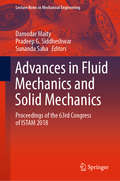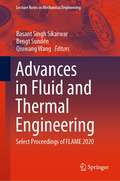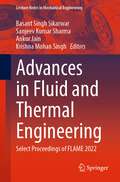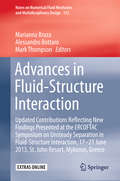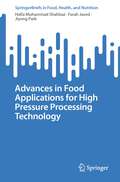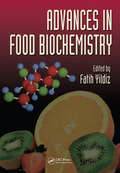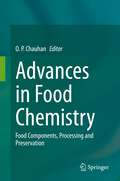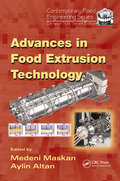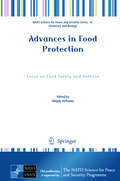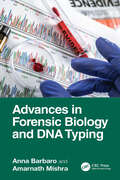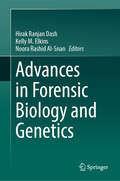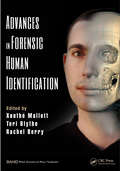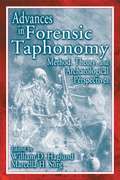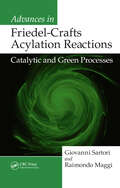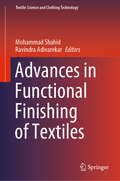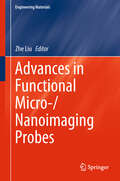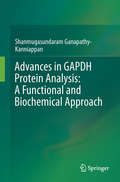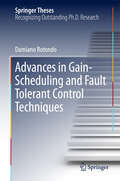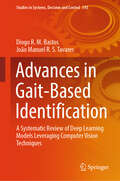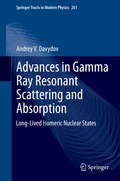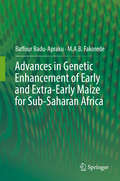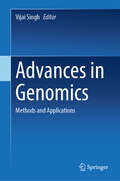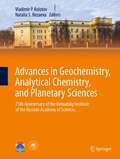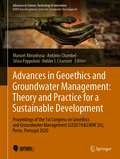- Table View
- List View
Advances in Fluid Mechanics and Solid Mechanics: Proceedings of the 63rd Congress of ISTAM 2018 (Lecture Notes in Mechanical Engineering)
by Damodar Maity Pradeep G. Siddheshwar Sunanda SahaThis book comprises select proceedings of the 63rd Congress of the Indian Society of Theoretical and Applied Mechanics (ISTAM) held in Bangalore, in December 2018. Latest research in computational, experimental, and applied mechanics is presented in the book. The chapters are broadly classified into two sections - (i) fluid mechanics and (ii) solid mechanics. Each section covers computational and experimental studies on various contemporary topics such as aerospace dynamics and propulsion, atmospheric sciences, boundary layers, compressible flow, environmental fluid dynamics, control structures, fracture and crack, viscoelasticity, and mechanics of composites. The contents of this book will serve as a useful reference to students, researchers, and practitioners interested in the broad field of mechanics.
Advances in Fluid and Thermal Engineering: Select Proceedings of FLAME 2020 (Lecture Notes in Mechanical Engineering)
by Bengt Sundén Basant Singh Sikarwar Qiuwang WangThis book comprises the select proceedings of the International Conference on Future Learning Aspects of Mechanical Engineering (FLAME 2020). This volume focuses on current research in fluid and thermal engineering and covers topics such as heat transfer enhancement and heat transfer equipment, heat transfer in nuclear applications, microscale and nanoscale transport, multiphase transport and phase change, multi-mode heat transfer, numerical methods in fluid mechanics and heat transfer, refrigeration and air conditioning, thermodynamics, space heat transfer, transport phenomena in porous media, turbulent transport, theoretical and experimental fluid dynamics, flow measurement techniques and instrumentation, computational fluid dynamics, fluid machinery, turbo machinery and fluid power. Given the scope of its contents, this book will be interesting for students, researchers as well as industry professionals.
Advances in Fluid and Thermal Engineering: Select Proceedings of FLAME 2022 (Lecture Notes in Mechanical Engineering)
by Basant Singh Sikarwar Ankur Jain Sanjeev Kumar Sharma Krishna Mohan SinghThis volume comprises the select proceedings of the 3rd Biennial International Conference on Future Learning Aspects of Mechanical Engineering (FLAME-2022). It aims to provide a comprehensive and broad-spectrum picture of state-of-the-art research and development in thermal and fluid engineering. Various topics covered include flow analysis, thermal systems, flow instability, renewable energy, hydel and wind power systems, heat transfer augmentation, biomimetic/ bioinspired engineering, heat pipes, heat pumps, multiphase flow/ heat transfer, energy conversion, thermal hydraulics of nuclear systems, refrigeration, and HVAC systems, computational fluid dynamics, fluid-structure interaction, etc. This volume will prove a valuable resource for those in academia and industry.
Advances in Fluid-Structure Interaction: Updated contributions reflecting new findings presented at the ERCOFTAC Symposium on Unsteady Separation in Fluid-Structure Interaction, 17-21 June 2013, St John Resort, Mykonos, Greece (Notes on Numerical Fluid Mechanics and Multidisciplinary Design #133)
by Mark Thompson Marianna Braza Alessandro BottaroThis book addresses flow separationwithin the context of fluid-structure interaction phenomena. Here, newfindings from two research communities focusing on fluids and structures arebrought together, emphasizing the importance of a unified multidisciplinaryapproach. The book covers the theory, experimental findings, numericalsimulations, and modeling in fluid dynamics and structural mechanics for bothincompressible and compressible separated unsteady flows. There is a focus onthe morphing of lifting structures in order to increase their aerodynamicand/or hydrodynamic performances, to control separation and to reducenoise, as well as to inspire the design of novel structures. The differentchapters are based on contributions presented at the ERCOFTAC Symposium onUnsteady Separation in Fluid-Structure Interaction held in Mykonos, Greece,17-21 June, 2013 and include extended discussions and new highlights. Thebook is intended for students, researchers and practitioners in the broad fieldof computational fluid dynamics and computational structural mechanics. It aimsat supporting them while dealing with practical issues, such as developingcontrol strategies for unsteady separation and applying smart materials andbiomimetic approaches for design and control.
Advances in Food Applications for High Pressure Processing Technology (SpringerBriefs in Food, Health, and Nutrition)
by Hafiz Muhammad Shahbaz Farah Javed Jiyong ParkThis Brief provides an overview of commercially successful current applications of high pressure processing (HPP) non-thermal technology. In recent years, HPP has gained acceptance in the industry for its use in the development of nutritious clean label food products which meet modern demands from health-conscious consumers. HPP products are now commercially available in many countries, and more than 400 HPP industrial equipment installations are currently in operation. Advances in Food Applications for High Pressure Processing Technology offers an in-depth discussion of recent applications of HPP for different food commodities, including fruit juices, vegetable and fruit products, meat products, ready-to-eat meals, avocado products, dairy products, dips and condiments, wet salads and sandwich fillings, fermented products and baby and infant foods.
Advances in Food Biochemistry
by Fatih YildizUnderstanding the biochemistry of food is basic to all other research and development in the fields of food science, technology, and nutrition, and the past decade has seen accelerated progress in these areas. Advances in Food Biochemistry provides a unified exploration of foods from a biochemical perspective. Featuring illustrations to elucidate m
Advances in Food Chemistry: Food Components, Processing and Preservation
by O. P. ChauhanThe book compiles the latest advances in food chemistry. It gives a detailed account of the changes in food components during food processing and storage. It analyses and describes different food components such as water, protein, fat, carbohydrates, minerals, vitamins, pigments, flavors, chemistry of plant tissues and animal tissues, milk, etc. The book also discusses the effect of different food processing operations on the food components. The book brings forth chapters authored by eminent researchers working in the area of Food Science and Technology. The book is an up-to-date compilation of recent advances in food chemistry and is useful for students, researchers, and faculty as well as to industry experts in food sciences.
Advances in Food Extrusion Technology (Contemporary Food Engineering)
by Medeni Maskan Aylin AltanA fresh view of the state-of-the-art, Advances in Food Extrusion Technology focuses on extruder selection, extrudate development, quality parameters, and troubleshooting in the 21st century extrusion process. In particular, the book:Introduces the history, nomenclature, and working principles of extrusion technologyPresents an overview of various t
Advances in Food Protection: Focus on Food Safety and Defense (NATO Science for Peace and Security Series A: Chemistry and Biology)
by Magdy HefnawyThe global food-supply chain is vulnerable to threats from a variety of directions. Hence food security and safety remains a hot topic worldwide in academic research arenas and food industry practices. This book describes efforts from academia, government, and industry to counter food terrorism and to protect the food supply against any threat. In addition, it evaluates the global food supply, production capabilities, and food availability during and after disasters. Articles in the book assess food safety emergencies, and the prevention of, and response to deliberate contamination by microbial or chemical substances. Minimization of health and economic risks following a terrorist act or unintentional contamination is likewise discussed. The book also examines novel preservation techniques, methods to produce safe food products, and other concerns for ensuring a stable and safe food supply.
Advances in Forensic Applications of Mass Spectrometry
by JehudaYinonRecent developments in analytical instrumentation have had an enormous influence on forensic analysis. The mass spectrometer is now an integral part of every forensic laboratory, resulting in greater analytical accuracy, more reliable identification, and lower detection limits. As the instrumental method of choice among forensic analysts, the mass
Advances in Forensic Biology and DNA Typing
by Anna Barbaro Amarnath MishraAdvances in Forensic Biology and DNA Typing examines a broad range of forensic DNA applications and topics, based on internationally recognized best practices. As a contributed volume that includes chapters by experts from around the world, the book covers a broad range of forensic DNA applications and topics. This includes current methods for DNA extraction and typing as well as other technologies and emergent techniques in the field such as Trace and Touch DNA, Forensic DNA Phenotyping (FDP), Forensic Investigative Genetic Genealogy (FIGG), Rapid DNA Biological Fluid Identification by epigenetics, and Pharmacogenomics. The book also explores the development and usage of forensic biology for the analysis of non- human samples and the relevance of DNA databases, management systems and quality certification in forensic.Key features:• Highlights sources of DNA (including biological fluids, hair, bones, teeth) detailing how to address the challenges of various sample types, quantities, and environmental factors• Presents best practices in investigative and collection procedures, as well as evaluative and testing methods, of biological samples• Addresses both human and non- human DNA analyses and applications for both criminal and wildlife investigationsAdvances in Forensic Biology and DNA Typing is a highly illustrated guide that will serve as a useful reference for forensic laboratory professionals, investigators, and students, as well as legal professionals.
Advances in Forensic Biology and Genetics
by Hirak Ranjan Dash Kelly M. Elkins Noora Rashid Al-SnanThe book explores the interdisciplinary field that merges biochemistry, cell biology, molecular biology, and genetics to unravel the mysteries of biological evidence in forensic investigations. Delving into the core of this dynamic discipline, the book unveils how forensic biological scientists leverage a diverse range of techniques to address complex questions posed by investigative agencies. The book meticulously covers different facets of forensic biology, from uncovering the origins of crucial body fluids to predicting the post-mortem time interval, while deciphering the cause and manner of death to individualizing biological samples. This book consolidates the latest breakthroughs in forensic biology and genetics, embracing both human and non-human DNA analyses, helpful for the forensic biological scientists. Chapters are written by researchers and practitioners from around the world. This book serves as an indispensable resource for investigating officers, forensic scientists, medical practitioners, researchers, and students.
Advances in Forensic Human Identification
by Teri Blythe Rachel Berry Xanthé MallettAs forensic human identification receives increased global attention, practitioners, policy makers, and students need an appropriate resource that describes current methods and modalities that have shaped today’s policies and protocols. A supplemental follow-up to Forensic Human Identification: An Introduction, Advances in Forensic Human Identification covers advances in the most well-known scientific techniques and discusses new and developing subjects and modalities of human identification.A collection of contributions from worldwide experts, the book embraces a broad context and looks at several issues beyond physical identification of human remains or offenders. The book examines online, sexual, and biometric identities and discusses problems associated with investigative practice, such as the developing use of the Internet as a distribution and communication medium for criminal activities. It also explores miscarriages of justice that can result from flawed applications or interpretations of forensic evidence. Finally, it looks at the future of forensic science in the United Kingdom in light of financial challenges and the closure of the Forensic Science Service. Where appropriate, case studies illustrate the use of techniques and the associated problems described in the text. The downloadable resources include images in full color.This volume provides an important contribution to the ongoing practitioner and academic debates surrounding the application of forensic technologies. The insight presented is destined to springboard further inquiry into enhanced techniques and underlies the need for more research into the appropriate use of identification techniques to solve the mysteries of the unknown.
Advances in Forensic Taphonomy: Method, Theory, and Archaeological Perspectives
by William D. Haglund Marcella H. SorgLiberally illustrated with photographs, maps, and other images, Advances in Forensic Taphonomy: Method, Theory, and Archaeological Perspectives offers modern techniques for obtaining clues from postmortem evidence. This bestselling reference examines techniques in recovery and analysis, coverage of mass grave investigation, applications of nuclear and mitochondrial DNA techniques, interpretation of burned human remains, the discrimination of trauma from postmortem change, and taphonomic interpretation of water deaths both at the scene and in the lab. It also discusses microenvironmental variation and decomposition in different environments, as well as geochemical and entomological analysis.
Advances in Friedel-Crafts Acylation Reactions: Catalytic and Green Processes
by Giovanni Sartori Raimondo MaggiUsed in the production of a wide number of fine chemicals and pharmaceuticals, the Friedel-Crafts acylation reaction represents a synthetic process of great interest to organic chemists of academia and industry. Nearly 40 years since the last major treatise on the topic and reflecting the growing emphasis on green technology, Advances in Friedel-Cr
Advances in Functional Finishing of Textiles (Textile Science and Clothing Technology)
by Mohammad Shahid Ravindra AdivarekarThis book provides a comprehensive overview of the field of functional finishing of textiles, describing the state-of-the-art research and well-established techniques applied in the textile industry, and covering all areas of textile dyeing and finishing. It is intended for academic researchers and professionals in related scientific and engineering fields, including textile engineering, chemistry, nanotechnology, material science, biotechnology and environmental science. The book also provides reference material for stakeholders looking for innovative technologies and insights into the environmental and sustainability issues in the development of functional textiles and related products.
Advances in Functional Micro-/Nanoimaging Probes (Engineering Materials)
by Zhe LiuThis book highlights the latest advances in functional micro/nano imaging probes and their applications for biomedical imaging and therapy. Given the rapid emergence of transdisciplinary research and applications in materials, chemical probes and translational medicine in recent years, scientists in these areas are expected to keep up to date on the latest technologies and advances to promote comprehensive innovations. Addressing this need, the book presents recently introduced features, emerging techniques, and new strategies, complemented by detailed illustrations. Covering the status quo and offering an outlook on the future, it benefits all readers with an interest in functional materials, especially micro/nano imaging materials for biomedical imaging applications, providing them with both vital updates and inspiration for their own research.
Advances in GAPDH Protein Analysis: A Functional and Biochemical Approach
by Shanmugasundaram Ganapathy-KanniappanThis book presents modern and classic analytical approaches that are crucial for the biochemical and functional characterization of the archetypal protein, glyceraldehyde-3-phosphate dehydrogenase (GAPDH). The distinguishing feature of the book is that it covers, in addition to other methods, some of the uncommon but valuable techniques as well. For example, in-gel visualization of enzyme activity, immunoblotting protocols for native (non-denatured) proteins, and proteins resolved by pH-gradient [IEF-isoelectrofocusing], etc. These expedient methods are relevant and vital for the verification of biochemical properties of GAPDH, or similar protein of interest. This work outlines detailed protocols that are essential to investigate classical (cellular) and recently reported extracellular (secretory) isoforms of GAPDH. Precisely, the book covers techniques pertinent to enzymatic and non-enzymatic analysis of GAPDH that include, but not limited to, electrophoretic mobility shift assay (EMSA), two-dimensional (2D)-immunoblotting, immunofluorescence/confocal microscopy, mass spectrometry, ion-exchange and affinity chromatography. Readers will discover the importance of the experimental methods described in the book as they relate to the evaluation of the role and significance of GAPDH. Furthermore, majority of the methods described in the book have also been validated in the author's laboratory, besides other research groups worldwide, underlining the repeatability and reproducibility of the protocols. Each method begins with an abstract and a brief background emphasizing its application and relevance. This will enable the readers to determine the choice of experimental design according to their research objectives. The book explains the methods systematically with ample illustrations to facilitate quick and easy comprehension of the practical knowledge. Although the book is focused on GAPDH, many of the protocols may be adopted to other proteins or enzymes with minimal modifications. Noteworthy, it is unequivocally established that GAPDH is a multifunctional protein involved in several cellular processes of health & disease conditions. Hence, this book will be a valuable practical guide for young researchers, scientists and clinician-scientists.
Advances in Gain-Scheduling and Fault Tolerant Control Techniques (Springer Theses)
by Damiano RotondoThis thesis reports on novel methods for gain-scheduling and fault tolerant control (FTC). It begins by analyzing the connection between the linear parameter varying (LPV) and Takagi-Sugeno (TS) paradigms. This is then followed by a detailed description of the design of robust and shifting state-feedback controllers for these systems. Furthermore, it presents two approaches to fault-tolerant control: the first is based on a robust polytopic controller design, while the second involves a reconfiguration of the reference model and the addition of virtual actuators into the loop. Inaddition the thesis offers a thorough review of the state-of-the art in gain scheduling and fault-tolerant control, with a special emphasis on LPV and TS systems.
Advances in Gait-Based Identification: A Systematic Review of Deep Learning Models Leveraging Computer Vision Techniques (Studies in Systems, Decision and Control #593)
by João Manuel R. S. Tavares Diogo R. BastosThis book provides a systematic review of gait-based person identification, categorizing studies into deep-learning and non-deep-learning approaches while analyzing key datasets and performance metrics. It explores challenges such as covariant factors, e.g., viewing angles, clothing, and accessories, and highlights advancements in real-world gait recognition systems. With a structured methodology and transparent review process, this work serves as a valuable reference for researchers and a foundation for future developments in biometric identification.
Advances in Gamma Ray Resonant Scattering and Absorption: Long-Lived Isomeric Nuclear States (Springer Tracts in Modern Physics #261)
by Andrey V. DavydovThis book presents the basics and advanced topics of research of gamma ray physics. It describes measuring of Fermi surfaces with gamma resonance spectroscopy and the theory of angular distributions of resonantly scattered gamma rays. The dependence of excited-nuclei average lifetime on the shape of the exciting-radiation spectrum and electron binding energies in the spectra of scattered gamma rays is described. Resonant excitation by gamma rays of nuclear isomeric states with long lifetime leads to the emission and absorption lines. In the book, a new gamma spectroscopic method, gravitational gamma spectrometry, is developed. It has a resolution hundred million times higher than the usual Mössbauer spectrometer. Another important topic of this book is resonant scattering of annihilation quanta by nuclei with excited states in connection with positron annihilation. The application of the methods described is to explain the phenomenon of Coulomb fragmentation of gamma-source molecules and resonant scattering of annihilation quanta to study the shape of Fermi surfaces of metals.
Advances in Genetic Enhancement of Early and Extra-Early Maize for Sub-Saharan Africa
by Baffour Badu-Apraku M. A. B. FakoredeThe book focuses on the principles and practices of tropical maize improvement with special emphasis on early and extra-early maize to feed the increasing population in Sub-Saharan Africa. It highlights the similarities and differences between results obtained in temperate regions of the world and WCA in terms of corroboration or refutation of genetic principles and theory of maize breeding. The book is expected to be of great interest to maize breeders, advanced undergraduates, graduate students, professors and research scientists in the national and international research institutes all over the world, particularly Sub-Saharan Africa. It will also serve as a useful reference for agricultural extension and technology transfer systems, Non-governmental Organizations (NGOs) and Community-Based Organizations (CBOs), seed companies and community-based seed enterprises, policy makers, and all those who are interested in generating wealth from agriculture and alleviating hunger and poverty in Sub-Saharan Africa.
Advances in Genomics: Methods and Applications
by Vijai SinghThis book provides a comprehensive overview of genomics and its diverse applications. Chapters cover genomics data generation methods, computational tools, gene annotation, transcriptomics, DNA barcoding, next-generation sequencing, functional genomics, metagenomics, synthetic genomics, microarray analysis, nutrigenomics, genome editing, and more. This book offers a valuable source of information for not only beginners in genomics, but also for students, researchers, scientists, clinicians, practitioners, policymakers, and stakeholders who are interested in harnessing the potential of genomics in many areas.
Advances in Geochemistry, Analytical Chemistry, and Planetary Sciences: 75th Anniversary of the Vernadsky Institute of the Russian Academy of Sciences
by Vladimir P. Kolotov Natalia S. BezaevaThis book presents 41 selected articles written by leading researchers from the Vernadsky Institute of Geochemistry and Analytical Chemistry, part of the Russian Academy of Sciences. The articles are grouped by the following topics: (1) Geochemistry, (2) Meteoritics, Cosmochemistry, Lunar and Planetary Sciences, (3) Biogeochemistry and Ecology, and (4) Analytical Chemistry, Radiochemistry, and Radioecology. The articles present recent experimental data, theoretical investigations, critical reviews, the results of computer modeling in the above-mentioned fields.Intended to provide a scientific “snapshot” of the institute, the book also includes content on its history, main scientific achievements and current goals, together with detailed descriptions of its 25 laboratories and three museums so as to promote new international collaborations.Given its scope, the book will be of interest to all scientists and graduate students working in the areas of geochemistry, analytical chemistry and radiochemistry, earth and environmental sciences, biogeosciences, meteoritics and planetary science, and to those seeking new collaboration opportunities in these areas in Russia.
Advances in Geoethics and Groundwater Management: Proceedings of the 1st Congress on Geoethics and Groundwater Management (GEOETH&GWM'20), Porto, Portugal 2020 (Advances in Science, Technology & Innovation)
by Silvia Peppoloni Helder I. Chaminé Manuel Abrunhosa António ChambelThis book gathers the peer-reviewed proceedings of the 1st congress on Geoethics & Groundwater Management (GEOETH&GWM'20), held in Porto, Portugal, in an online format on 18-22 May 2020. Hosted in School of Engineering (ISEP), Polytechnic of Porto based on Porto city (a UNESCO World Heritage Site), the international conference focused on what has now been dubbed “hydrogeoethics”, a novel transdisciplinary, scientific field integrating all dimensions of geoethics in groundwater science and practice. Given its scope, the book is of interest to all researchers and practitioners in the geosciences, hydrology, water resources, hydrogeology, natural resources management, environment, engineering, law, sociology, education, philosophy, culture, among others.This joint congress is the result of a collaborative agreement between the IAH (International Association of Hydrogeologists) and IAPG (International Association for Promoting Geoethics) and reflects the need for concerted actions to achieve sustainable development.The diversity, scale, significance and increasing magnitude of anthropogenic interactions with aquifers and groundwater, which often involve conflicting values or interests, call for analysis, discussions and decisions on the part of the agents involved, e.g. groundwater scientists, policymakers, managers, organisations, professionals and citizens. This approach calls for a responsible, sustainable and human approach to groundwater use and management.The groundwater community involved in the exploration and exploitation, use and management of this increasingly vital natural resource is becoming more and more aware that ethical issues pervade all our attitudes from concept to action and need to be addressed. Diverse values and cultures, science and education, law and policies, human and natural environments and the public and the economic sectors view groundwater and its value and/or role differently. The authors believe that in a globalised and interconnected world, common ground must be found in the interest of peace, human development and sustainability. The main topics covered here include:1. Fundamentals of hydrogeoethics: cultures, principles and geoethical values on groundwater science and engineering2. Lessons for a resilient and sustainable future with hydrogeoethics: case studies of geoethics in groundwater science-engineering, profession, and management3. Scientific and humanistic components of hydrogeoethics in groundwater education and professional training 4. Socio-hydrogeology and ethical groundwater management 5. Geoethics of decision making under uncertainty and ethical issues in neglecting groundwater functioning 6. Groundwater: geological, legal, social, and ethical challenges of a unique natural resource
